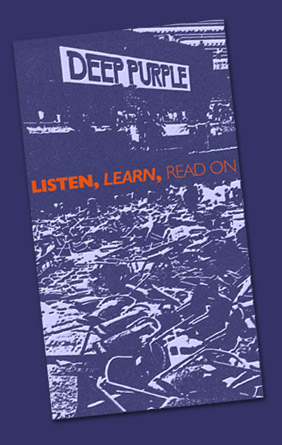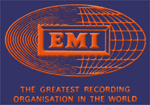|
DISC
ONE : PRE PURPLE & DEEP PURPLE Mk1
[1] The
Outlaws / Keep A Knockin'
1964 •
Ritchie Blackmore. This was the band's last UK single, featuring two
manic Blackmore guitar solos. Produced by the legendary Joe Meek. Remastered
a-side.
[2] M.I.5
/ You'll Never Stop Me Loving You R
1966 •
featuring Rod Evans
(and Ian Paice). The a-side of their one and only single, this was Evans'
first recording, a very Gene Pitney-ish smoocher.
[3] M.I.5 /
Only Time Will Tell R C
1966 •
featuring Ian Paice (and Rod Evans). A typical mid-sixties beat number
with Paice on drums, the b-side of the above single. Never reissued
before.
[4] Johnny Kidd
& The Pirates / Send For That Girl R
1966 •
Nick Simper. Simper only recorded a few tracks with Kidd, who died in
a car-crash in 1966.
[5] Santa Barbara
Machine Head / Porcupine Juice
1967 •
Jon Lord. Recorded as a try-out for a new band, they ran out of money
after recording just three instrumental tracks, which were then shelved.
The full session is on the Pre
Purple People CD.
[6] Episode
Six / I Can See Through You
1967 •
Roger Glover (and Ian Gillan). An early example of a Glover composition,
issued on a Pye a-side, and one of the band's best studio performances
(Gillan on vocals).
[7] Episode Six
/ Mr Universe
1968 •
Ian Gillan (and Roger Glover). One of the earliest Gillan screams on
record, a Chapter One b-side, and a song he later revisited in 1979
with his own band.
[8] Trapeze
/ Medusa
1970 •
Glenn Hughes. A good example of this power-trio in early progressive
rock mode on their second album, with Hughes on bass and vocals.
[9] The Government
/ Does Anybody Really Know What Time It Is
1971 •
David Coverdale. A faithful cover of an obscure 1969 Chicago b-side
from Coverdale's only known pre-Purple studio session.
[10] Zephyr
/ See My People Come Together
1971 •
Tommy Bolin. From their much improved second album, an example of Bolin's
early compositional skill and confident guitar work.
Deep Purple
[11] Hush
1968 •
Shades Of Deep Purple. Taken off the album, this strong cover gave them
their first big American hit and an early boost to their career. From
the remastered CD.
[12] Help
1968 •
Shades Of Deep Purple. The band wanted this cover of a Beatles track
as their debut single but were over-ruled. From the remastered CD.
[13] Shield
1969 •
The Book Of Taliesyn. A strong original number from the second album
with more than a hint of psychedelia. From the remastered CD.
[14] Listen,
Learn, Read On
1969 •
The Book Of Taliesyn.This original number from the second LP inspired
the sleeve illustration. From the remastered CD.
[15] Kentucky
Woman
1969 •
The Book Of Taliesyn. Neil Diamond was pleased when the band covered
one of his numbers. The Book Of Taliesyn was recorded in 1968 but not
issued in the UK until 1969. From the remastered CD.
[16] Playground
1968 •
The Book of Taliesyn out-take. Recorded for the LP but left without
a vocal and not issued until 1989. This mix by Guy Massey was done in
1998 at Abbey Road for the 2000 remastered CD.
[17] Emmaretta
1969 •
a-side. Recorded in January during the third album sessions for release
as a single. From the remastered CD.
[18] The Bird
Has Flown
1969 •
U.S. b-side. Recorded at the same session, this version was only issued
in America on a single. From the remastered CD.
|


